Introduction
NEMA 17 stepper motors are one of the most commonly used stepper motors in the industry due to their compact size, high torque output, and ease of use. NEMA 17 stepper motors are popularly used in 3D printers, CNC machines, robotics, and other industrial automation applications.
Proper wiring of the NEMA 17 stepper motor is crucial to its performance and long-term durability. The wiring of a stepper motor is not as straightforward as that of a regular DC motor, and it can be confusing for beginners who are not familiar with stepper motor technology. There are four wires in a NEMA 17 stepper motor, and it is crucial to understand which wires are which to ensure proper wiring for optimal performance.
This article is dedicated to providing a comprehensive guide to NEMA 17 stepper motor wiring. It covers topics such as how to identify the motor’s wires, the correct way to connect the wires to the driver board, and how to troubleshoot common wiring issues. Additionally, the article provides wiring diagrams and examples, making it easy for even beginners to understand.
By following this guide, readers will be able to wire their NEMA 17 stepper motor correctly and confidently, ensuring smooth and reliable operation for their projects. The proper setup and wiring will allow the stepper motor to execute precise movements, resulting in high-quality output for 3D printers, CNC machines, and other projects.

With this guide, readers will be able to confidently wire their NEMA 17 stepper motor and take their projects to the next level.
What is NEMA?
NEMA stands for the National Electrical Manufacturers Association, which is an organization that develops technical standards for the manufacturing of electrical equipment and associated materials. They define standards used in North America for various grades of electrical enclosures typically used in industrial applications, each rated to protect against personal access to hazardous parts and designated environmental conditions.
NEMA also provides resources and guidance to its members to ensure they have a competitive edge in today’s rapidly changing marketplace.
What Is NEMA Rating?
This rating system is used extensively in North America and defines the types of environments in which an electrical enclosure can be used. NEMA ratings are used to ensure that electrical equipment is housed in enclosures that provide adequate protection against hazards and environmental factors that could damage the equipment or cause injury to personnel.
NEMA ratings are classified based on the degree of protection provided by an enclosure against certain environmental factors, such as water, dust, oil, coolant, or corrosive atmospheres that contain acetylene or gasoline.
NEMA 17 Stepper Motor
A NEMA 17 stepper motor is a specific type of stepper motor that has a faceplate of 1.7 x 1.7 inches (42.3 mm × 42.3 mm) and a step angle of 1.8 degrees, which means it requires 200 steps to complete one full revolution. These motors are widely used in various applications, such as 3D printers, CNC machines, robotics, and automation systems. NEMA 17 stepper motors provide high accuracy and torque at low speeds, making them ideal for precision motion control tasks [1].
They are typically available in various holding torque ratings and can be wired as bipolar or unipolar depending on the specific application requirements.

Technical Specifications of NEMA 17
Some common technical specifications of NEMA 17 stepper motors include:
- Faceplate size: 1.7 x 1.7 inches (42.3 mm × 42.3 mm);
- Step angle: 1.8 degrees;
- Holding torque: can range from around 26 to 76 oz-in or higher depending on the specific model and manufacturer;
- Current rating: can range from around 0.4 A to 2.0 A or higher depending on the specific model and manufacturer;
- Voltage rating: can range from around 2 V to 12 V or higher depending on the specific model and manufacturer;
- Number of phases: 2 or 4;
- Shaft diameter: typically around 5 mm, but can vary depending on the specific model and manufacturer;
It’s important to check the datasheet for specific technical specifications of a particular NEMA 17 stepper motor as they can vary depending on the manufacturer and model.
NEMA 17 Stepper Motor Dimensions
The faceplate size of the NEMA 17 stepper motor is 1.7 x 1.7 inches or 42.3 mm x 42.3 mm. The length and weight of the motor can vary depending on the specific model and manufacturer. It’s important to check the datasheet for specific dimensions of a particular NEMA 17 stepper motor as they can vary depending on the manufacturer and model.
NEMA 17 Stepper Motor Pinout
NEMA 17 stepper motors are widely used in various applications due to their compact size and precise control over rotational movements. These motors come in two different configurations: unipolar and bipolar. Understanding the pinout for each type is essential for correct wiring and controlling these motors. In this post, we will explore the pinout configurations for NEMA 17 stepper motors in both unipolar and bipolar modes.

Unipolar Motors
Unipolar NEMA 17 stepper motors have five or six wires, depending on the specific model. These motors are relatively easier to wire and control compared to bipolar motors. Let’s take a look at the typical pinout for a unipolar NEMA 17 stepper motor:
- Coil A (Center-Tap): This wire is often labeled as “CT” or “Center-Tap”. It is the common connection between the two halves of the motor’s coil. In some motors, this wire may not exist, and both halves of the coil are internally connected;
- Coil A – Wire 1: This wire is connected to one end of coil A;
- Coil A – Wire 2: This wire is connected to the other end of coil A;
- Coil B – Wire 1: This wire is connected to one end of the coil B;
- Coil B – Wire 2: This wire is connected to the other end of the coil B;
In a unipolar motor, the two halves of each coil are connected to the power supply using transistors. By controlling the transistors’ state, you can energize or de-energize the individual coils and control the motor’s rotation.
Bipolar Motors
Bipolar NEMA 17 stepper motors have four wires, which makes them slightly more complex to wire and control compared to unipolar motors. However, they offer higher torque and more precise control over movements. Let’s explore the pinout for a bipolar NEMA 17 stepper motor:
- Coil A – Wire 1: This wire is connected to one end of coil A;
- Coil A – Wire 2: This wire is connected to the other end of coil A;
- Coil B – Wire 1: This wire is connected to one end of the coil B;
- Coil B – Wire 2: This wire is connected to the other end of the coil B;
In a bipolar motor, the two coils are not center-tapped like in a unipolar motor. Instead, each coil is controlled independently. By controlling the current flow through the coils and reversing the direction of the current, you can control the motor’s rotation [2].
It is important to note that the wiring and control methods for NEMA 17 stepper motors can vary between different manufacturers and models. Always refer to the datasheet or documentation provided by the motor manufacturer to ensure accurate wiring and control.
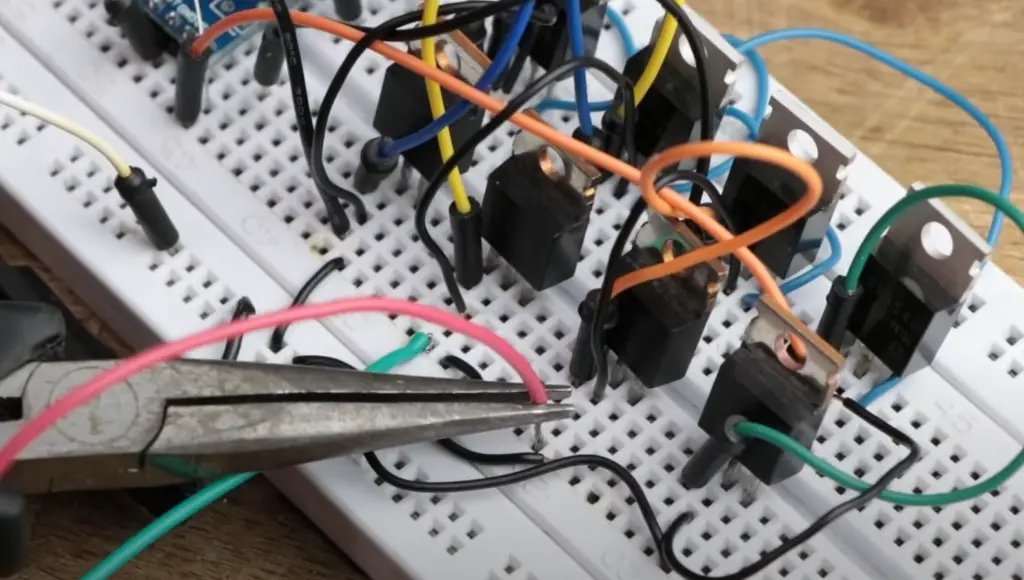
Applications Of NEMA 17 Stepper Motor
NEMA 17 stepper motors are widely used in various applications that require precise control over rotational movements. Their compact size, high torque, and ability to step in small increments make them suitable for a wide range of projects.
Let’s explore some common applications where NEMA 17 stepper motors are frequently used:
- Robotics: NEMA 17 stepper motors find extensive use in robotics. They are employed in robotic arms, grippers, and joints to enable precise and controlled movements. Stepper motors offer the advantage of accurate positioning, allowing robots to perform tasks with high precision and repeatability;
- 3D Printers: NEMA 17 stepper motors are a popular choice for driving the X, Y, and Z axes in 3D printers. Their ability to move in small increments ensures precise control over the printer’s movements, resulting in accurate and detailed prints. Stepper motors are well-suited for the layer-by-layer additive manufacturing process employed in 3D printing;
- CNC Machines: Computer Numerical Control (CNC) machines rely on NEMA 17 stepper motors for controlling the movement of the cutting tools. These motors enable CNC machines to perform complex milling, cutting, and engraving operations with high accuracy. Stepper motors are essential for achieving the required precision and ensuring consistent results in CNC machining [3];
- Automation Systems: NEMA 17 stepper motors play a crucial role in various automation systems. They are used in conveyor belts, linear actuators, and automated positioning systems to control movement and positioning. Stepper motors provide the necessary control and accuracy to automate industrial processes, assembly lines, and other automated systems;
- Camera Systems: NEMA 17 stepper motors are utilized in camera systems, including pan-tilt mechanisms and camera sliders. They enable smooth and precise movements, allowing photographers and videographers to capture shots from different angles and perspectives. Stepper motors provide the required control for accurate positioning and controlled camera movements;
- Medical Equipment: NEMA 17 stepper motors are employed in various medical devices and equipment. They are used in robotic surgical systems, automated sample handling, and laboratory automation. Stepper motors ensure precise control and accurate movements in medical applications, contributing to improved diagnostics and treatments;
- Automotive Applications: NEMA 17 stepper motors are utilized in automotive applications such as headlight leveling systems, throttle control, and HVAC actuators. Their ability to provide controlled and accurate movements is beneficial for maintaining optimal performance and functionality in vehicles;

Controlling NEMA 17 Stepper Motor with Arduino and A4988 Stepper Driver Module
1) Components Required:
- NEMA 17 Stepper Motor: This is the actual motor that will be controlled. NEMA 17 refers to the motor’s size and mounting dimensions. It is a popular choice for many projects due to its compact size and reasonable torque;
- A4988 Stepper Driver Module: This module acts as an interface between the Arduino and the stepper motor. It provides the necessary current and voltage regulation to drive the motor correctly. The A4988 module also allows micro-stepping, which enables smoother and more precise motor movements [4];
2) Circuit Diagram
To connect the NEMA 17 stepper motor to the Arduino using the A4988 stepper driver module, the circuit consists of the following connections:
- VCC and GND: Connect the VCC and GND pins of the A4988 module to the 5V and GND pins of the Arduino, respectively. This provides power to the stepper driver module;
- Step and Direction Pins: Connect the Step and Direction pins of the A4988 module to any digital pins of the Arduino. These pins control the motor’s rotation and direction;
- Enable Pin: Connect the Enable pin of the A4988 module to a digital pin of the Arduino. This pin enables or disables the stepper motor. You can connect it to a digital pin and control it through the Arduino to turn the motor on or off;
- Motor Connections: Connect the four motor wires of the NEMA 17 stepper motor to the A4988 module’s A, A, B, and B pins. The wire colors may vary, but generally, two wires are connected to each pin;
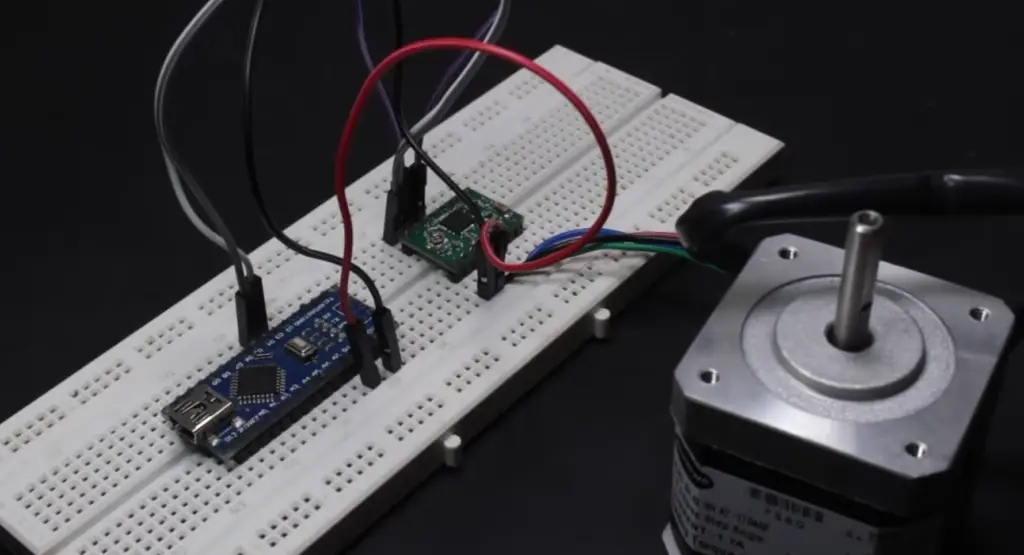
3) Code Explanation
To control the NEMA 17 stepper motor with the Arduino and A4988 module, you need to upload the appropriate code to the Arduino. Here’s a basic example:
#include
// Define the number of steps per revolution
const int stepsPerRevolution = 200;
// Initialize the stepper motor object
Stepper myStepper(stepsPerRevolution, 8, 9, 10, 11);
void setup() {
// Set the speed of the motor in RPM
myStepper.setSpeed(60);
}
void loop() {
// Rotate the motor clockwise for one revolution
myStepper.step(stepsPerRevolution);
delay(1000); // Delay for one second
// Rotate the motor counterclockwise for one revolution
myStepper.step(-stepsPerRevolution);
delay(1000); // Delay for one second
}
Let’s break down the code:
- We include the Stepper library, which provides functions to control the stepper motor;
- We define the number of steps per revolution for our motor (200 steps for a standard NEMA 17 motor);
- We create a Stepper object named “myStepper” and pass the number of steps per revolution and the motor pin connections (8, 9, 10, and 11) as parameters;
- In the setup function, we set the speed of the motor using the setSpeed() function. In this example, we set it to 60 RPM (revolutions per minute), but you can adjust it according to your requirements;
- Inside the loop() function, we control the motor’s rotation. Firstly, we call the step() function with the stepsPerRevolution parameter, which rotates the motor clockwise for one revolution;
- Then, we introduce a delay of 1 second using delay(1000). This pause allows the motor to complete its rotation before proceeding to the next step;
- Next, we call the step() function again with a negative value of stepsPerRevolution, which rotates the motor counterclockwise for one revolution. Again, we introduce a 1-second delay after this step;
- By repeating this loop, the motor will continuously rotate clockwise and counterclockwise, with a 1-second pause between each rotation [5];
You can modify the code to suit your specific requirements. For example, you can change the number of steps per revolution, adjust the speed, or introduce additional control logic based on external inputs or sensors.
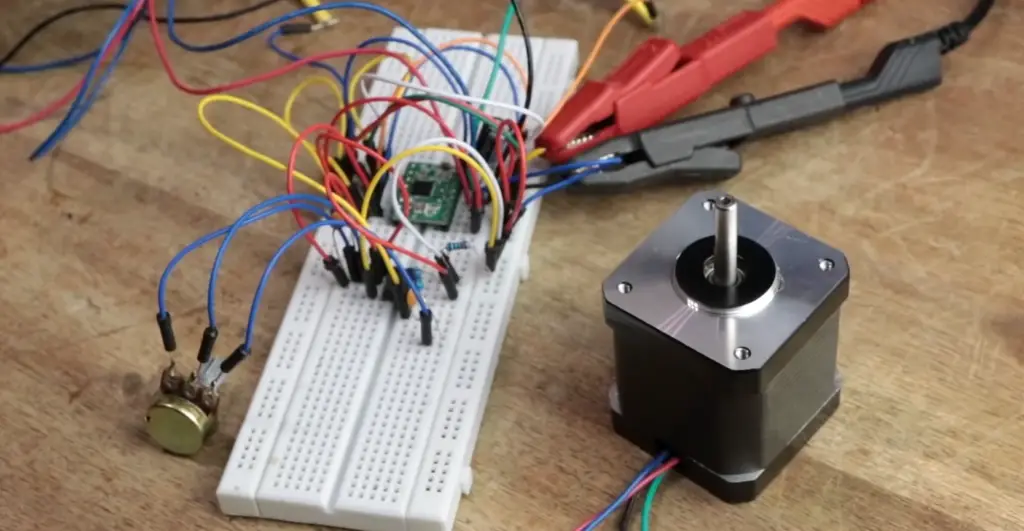
FAQ
1. What is the RPM of the NEMA 17 stepper motor?
The rotational speed of a NEMA 17 stepper motor, or any stepper motor for that matter, depends on several factors such as the voltage and frequency of the signal applied to it, the number of steps per revolution, and the load. The speed range of a NEMA 17 stepper motor varies from around 100 to 300 RPM.
2. How strong is a NEMA Stepper Motor?
The strength, or torque, of a NEMA stepper motor, can vary depending on the specific model and manufacturer. However, NEMA 17 stepper motors are generally known for providing high torque at low speeds. The holding torque of a NEMA 17 stepper motor can range from around 26 to 76 oz-in or higher.
3. Are all NEMA 17 Stepper motors the same?
No, not all NEMA 17 stepper motors are the same. While they all share the same faceplate size and step angle, other specifications such as holding torque, current rating, voltage rating, and shaft diameter can vary depending on the specific model and manufacturer.
4. What does NEMA 17 stand for?
NEMA 17 is a designation given by the National Electrical Manufacturers Association (NEMA) to a specific type of stepper motor with a faceplate size of 1.7 by 1.7 inches. The 17 refers to the mounting dimensions of the motor.
5. Do 3D printers use stepper or servo motors?
3D printers generally use stepper motors as they provide accurate positioning and control at low speeds, which is important for printing fine details and intricate designs. Some advanced 3D printers may use servo motors for certain applications.
6. Is NEMA 17 bipolar or unipolar?
NEMA 17 stepper motors can be wired as either bipolar or unipolar depending on the specific application requirements. Bipolar motors have two wires per phase and require a more complex driver circuit, while unipolar motors have five or six wires per phase and are easier to drive but less efficient.
7. What voltage should NEMA 17 run at?
The voltage rating for a NEMA 17 stepper motor can vary depending on the specific model and manufacturer. However, they typically operate in the range of 2 V to 12 V or higher.
8. What are the 4 wires on a stepper motor?
The 4 wires on a stepper motor correspond to 2 coils with a center tap each. Generally, the wire colors are active low (cathode) and active high (anode) for each coil in the stepper motor. The wires are used to control the direction and speed of the motor.
9. How to choose the power supply for stepper motor NEMA 17?
To choose the correct power supply for a NEMA 17 stepper motor, you need to refer to the manufacturer’s datasheet for the specific motor to determine the voltage and current requirements.
Generally, a power supply with a voltage slightly higher than the rated voltage of the motor is recommended. The current rating of the power supply should be at least the same as the maximum current that the motor will draw.
10. How much current does a NEMA 17 need?
The current rating for a NEMA 17 stepper motor depends on the specific model and manufacturer, but it typically ranges from 0.5 to 2.5 amps per phase. It’s important to refer to the datasheet for the specific motor to determine its current rating [7].
11. How much power does a NEMA 17 need?
The power rating of a NEMA 17 stepper motor depends on the voltage and current requirements of the motor. The power can be calculated by multiplying the voltage and current together. For example, if a NEMA 17 stepper motor requires 2 amps at 12 volts, then the power required by the motor would be 24 watts.
12. Does the stepper motor wire order matter?
Yes, the wire order of a stepper motor is important to ensure that the motor rotates correctly and as expected. In most cases, stepper motors will have a prescribed wire order that can be found in the motor datasheet or technical manual.
13. Is NEMA 17 AC or DC?
NEMA 17 stepper motors are DC motors. They operate by receiving a sequence of electrical signals to each coil within the motor to produce rotation.
14. Can I run NEMA 17 on 24V?
Yes, some NEMA 17 stepper motors can be run on a 24V power supply. However, it is important to check the manufacturer’s specifications for the specific motor to ensure that it can handle a 24V power supply.
15. What is the NEMA 17 cable size?
The cable size for a NEMA 17 stepper motor depends on the current rating of the motor. Typically, a minimum of 18-20 AWG wire is recommended. However, it is always best to refer to the manufacturer’s datasheet for the specific motor to determine the recommended cable size [8].
16. Why use 3-wire instead of 2-wire?
A 3-wire configuration can provide better performance and control compared to a 2-wire configuration in certain applications. In a 3-wire configuration, there is a center tap on each coil, which allows for more precise current control and reduces the likelihood of electrical noise and interference. Additionally, a 3-wire configuration can allow for smoother and more precise movement of the motor.
17. How many wires are needed for a stepper motor?
The number of wires needed for a stepper motor depends on its configuration. Most stepper motors will require at least 4 wires, which correspond to 2 coils with a center tap each. However, there are other configurations that may require more wires, such as 6-wire and 8-wire motors. It’s important to refer to the manufacturer’s datasheet or technical manual to determine the number of wires required for a specific stepper motor.
18. What is the best voltage for stepper motors?
The best voltage for a stepper motor can vary depending on the specific model and manufacturer of the motor. It is important to refer to the manufacturer’s datasheet for the motor to determine the recommended voltage range. Generally, a voltage slightly higher than the rated voltage of the motor is recommended for optimal performance.
19. Does polarity matter on a stepper motor?
Yes, polarity does matter on a stepper motor. The wires on a stepper motor are typically labeled as A+, A-, B+, and B-. The correct polarity must be observed when connecting the motor to a power supply or controller. If the polarity is reversed, the motor may not function properly or could be damaged.
20. What is “17” in “NEMA 17”?
The “17” in “NEMA 17” refers to the faceplate size of the motor in units of 1.8 inches. This indicates that the distance between the mounting holes on the faceplate of the motor is approximately 1.7 inches [9].
21. What is the max temp for NEMA 17?
The maximum temperature for a NEMA 17 stepper motor can depend on the specific model and manufacturer, but it generally ranges from 176-266 degrees Fahrenheit. It’s important to refer to the datasheet for the specific motor to determine its maximum temperature rating.
22. How much torque does NEMA 17 output?
The torque output of a NEMA 17 stepper motor can vary depending on the specific motor and the operating conditions. The torque output can be affected by the current, speed, and step size of the motor. Generally, the torque output ranges from 12 to 50 Ncm (Newton centimeters) [10].
23. Is it bad to manually move the stepper motor?
It is generally not recommended to manually move a stepper motor as it can damage the motor or cause misalignment. Stepper motors are designed to be controlled electronically using a controller or driver that sends precise signals to the motor.
24. Do stepper motors need constant voltage?
Stepper motors do not necessarily require a constant voltage, but they do require a constant current. The current supplied to the stepper motor must be regulated to prevent damage to the motor and ensure accurate positioning. This is typically achieved using a stepper motor driver that can regulate the current and voltage supplied to the motor.
Useful Video: Interfacing NEMA 23 | NEMA 17 | NEMA 34 with TB6600 stepper motor driver
References
- https://www.etechnophiles.com/guide-to-nema-17-stepper-motor-dimensions-wiring-pinout/
- https://www.ascopower.com/us/en/resources/articles/what-is-nema.jsp
- https://www.psicontrolsolutions.com/blog/nema-standards/
- https://www.nema.org/
- https://reprap.org/wiki/NEMA_17_Stepper_motor
- https://components101.com/motors/nema17-stepper-motor
- https://www.omc-stepperonline.com/nema-17-stepper-motor
- https://circuitdigest.com/microcontroller-projects/controlling-nema-17-stepper-motor-with-arduino-and-a4988-stepper-driver-module
- https://particle.hackster.io/ingo-lohs/stepper-a-first-introduction-to-nema-17-ac15d7
- https://electrobes.com/product/nema17-12-24v-stepper-motor-1-8-step-6-wire/





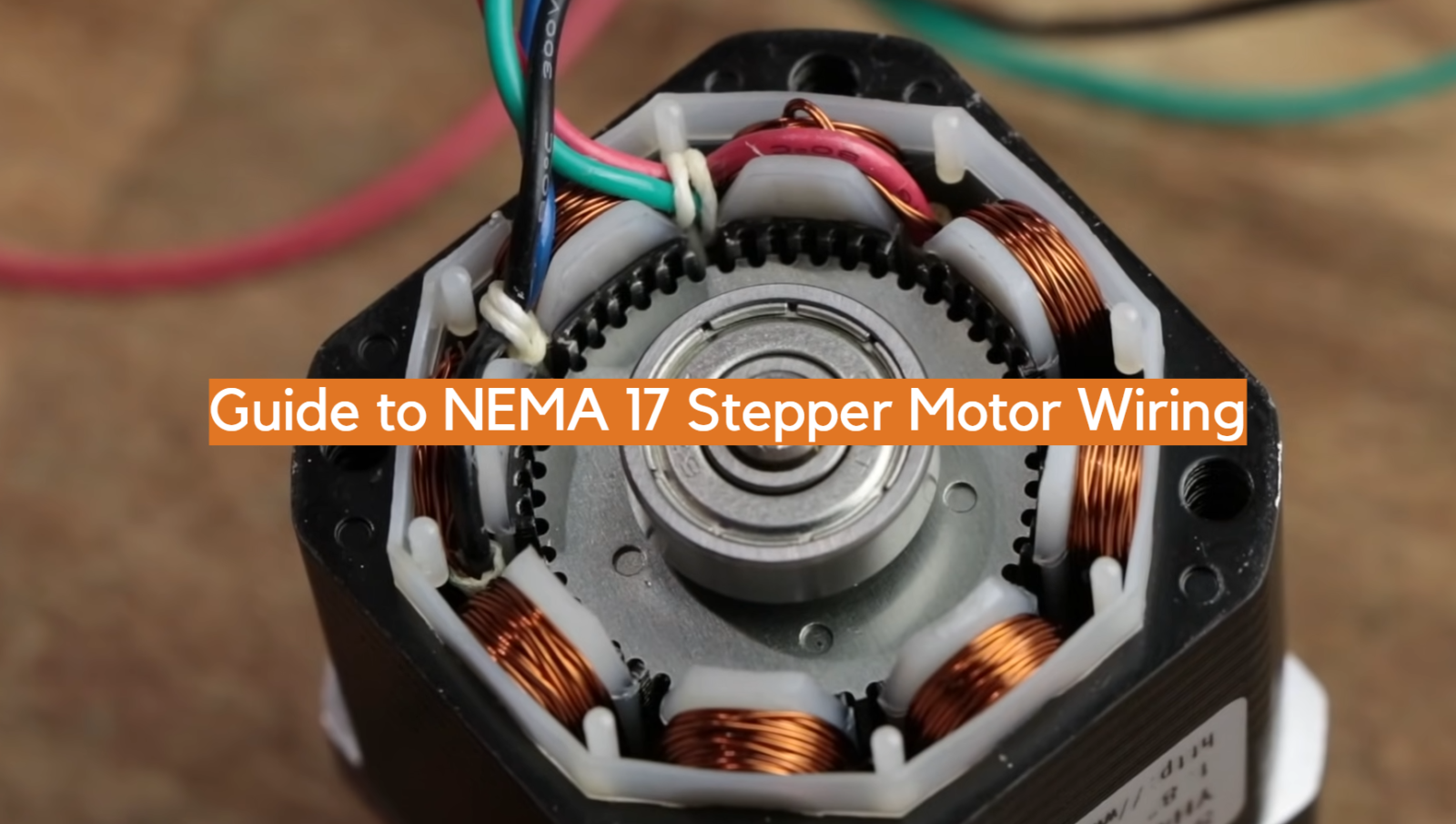




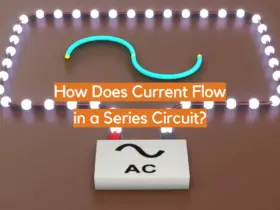
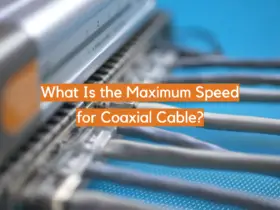


Leave a Reply